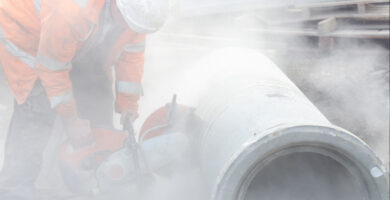Straight Talk about Mesothelioma, a blog series created by Michael T. Milano, M.D., Ph.D., a radiation oncology specialist, as a resource for mesothelioma patients and their loved ones.
First and foremost: the pleura is a very thin membrane that lines the outside surface of the lungs and chest cavity. There are, in fact, 2 layers of pleura. The visceral pleura covers the entire lung surface and the parietal pleura covers the inside of the chest cavity. Additionally, there are pleura linings which cover the outside of the heart (known as “pericardium”), the organs located in the middle of the chest (known as “mediastinum”), and the diaphragm.
In practice, the 2 layers of pleura are often discussed as being 1 collective membrane. Both pleural layers are very thin, transparent, and paper-like. The color of the pleura varies from light gray to pink. Texture-wise, the pleura is very similar to what one feels when one runs a finger over a clean dish covered with detergent – it has a soapy-like feel that is smooth and delicate. The pleural lining is very fragile; it has no strength and can easily be traumatized.
What Is the Function of the Pleura?
Between the 2 pleural linings, there is a small space, which is known as the pleural cavity. This cavity contains about a cup’s worth of fluid (about 50 mls), and this fluid lubricates the surfaces, which, in turn, permit the lungs to slide effortlessly. Such fluid helps the lung expand and contract with minimal effort. The pleural fluid also generates surface tension, which helps pull the parietal and visceral pleura together. This act ensures that when the chest cavity expands, the lung expands as well – allowing the lungs to be filled up with air.
On a microscopic scale, the cells inside of the pleural lining also are able to control the amount of fluid within the cavity. If the fluid starts to accumulate, this could become a problem. Surplus fluid in the cavity can result in less space for the lung to expand and, consequently, the patient would develop shortness of breath, which is the first sign of mesothelioma, a lethal cancer caused exclusively by asbestos.
Does the Pleura Surface Have Nerves & Blood Vessels?
The pleural surface that covers the chest wall (parietal pleura) has a rich supply of nerves that can sense pressure, temperature, and pain. This rich supply of nerves is the very reason why when you break your ribs, get hit in the chest area, or have masses growing in the pleura (as in mesothelioma), you will feel intense pain or an odd and continuous ache. On the other hand, the visceral pleura, which covers the lung, has no nerves and that is the reason why lung cancers do not cause as intense of a pain.
Both the parietal and visceral pleura also have a very large blood supply. The blood comes from blood vessels which run inside the chest wall and to and from the lungs. This is why when one experiences a certain trauma to the chest, blood quickly starts to accumulate in the chest cavity – this is an extremely dangerous condition.
What Types of Disorders Affect the Pleura?
There are several significant disorders that can affect the pleura, which include:
- Effusion, or accumulation of fluid
- Pneumothorax, or accumulation of excess air
- A mass or a tumor, which can either be benign or malignant
When an individual is exposed to asbestos fibers, these fibers can be inhaled and become lodged in the lungs. Some of these asbestos fibers can cross the lung surface and enter the pleural cavity. These asbestos fibers are usually fought off by the body’s defense cells, but because of the solid nature of these fibers, they aren’t easily broken down. The body responds by sending more defense cells to the pleura.
Over time, the asbestos fibers in the pleural cavity can overwhelm the defense cells and stimulate an inflammatory reaction. The 2 pleural surfaces can become “stuck together” and the resulting inflammation can also lead to pain. Because the 2 pleural surfaces are attached to one another, the lung in this area is no longer able to expand. What happens is that the lung essentially gets trapped. As the asbestos fibers overcome the body’s defense cells, changes occur in the cells, and these newly deformed cells can slowly evolve into a lethal cancer known as a mesothelioma.
Can the Pleural Surfaces Heal?
In most cases, where the pleural surface has been violated with trauma or an infection, the pleura has a tremendous ability to heal within only a few months. However, when an individual has a cancer, the cancer has to be removed. In the case of mesothelioma, the entire pleural lining has to be removed in order for there to be a cure. Once the pleural lining is removed, one can live a normal life but will lack physical endurance.
Removal of the pleural is a major surgical undertaking, and is usually only an option for those who are healthy enough to undergo such an invasive procedure. The surgery can be incredibly difficult and long, but for some mesothelioma patients, such a surgery can be curative.










